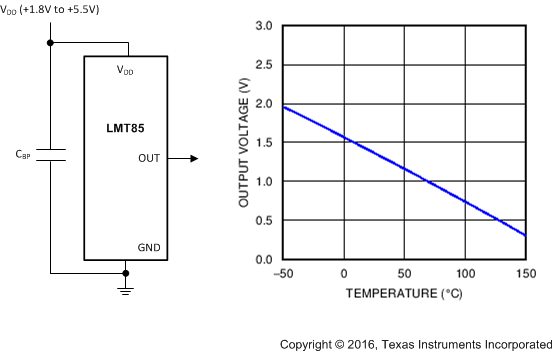ZHCSCG0E March 2013 – October 2017 LMT85
PRODUCTION DATA.
1 特性
- LMT85LPG(TO-92S 封装)具有快速热时间常量,典型值为 10s(气流速度为 1.2m/s)
- 非常精确:典型值 ±0.4°C
- 1.8V 低压运行
- -8.2mV/°C 的平均传感器增益
- 5.4µA 低静态电流
- 宽温度范围:–50°C 至 150°C
- 输出受到短路保护
- 具有 ±50µA 驱动能力的推挽输出
- 封装尺寸兼容符合行业标准的 LM20/19 和 LM35 温度传感器
- 具有成本优势的热敏电阻替代产品
3 说明
LMT85 是一款高精度 CMOS 温度传感器,其典型精度为 ±0.4°C(最大值为 ±2.7°C),且线性模拟输出电压与温度成反比关系。1.8V 工作电源电压、5.4μA 静态电流和 0.7ms 开通时间可实现有效的功率循环架构,以最大限度地降低无人机和传感器节点等电池供电 应用 的功耗。LMT85LPG 穿孔 TO-92S 封装快速热时间常量支持非板载时间温度敏感型 应用, 例如烟雾和热量探测器。 得益于宽工作范围内的精度和其他 特性, 使得 LMT85 成为热敏电阻的优质替代产品。
对于具有不同平均传感器增益和类似精度的器件,请参阅 类似替代器件 了解 LMT8x 系列中的替代器件。
器件信息(1)
| 器件型号 | 封装 | 封装尺寸(标称值) |
|---|---|---|
| LMT85 | SOT (5) | 2.00mm × 1.25mm |
| TO-92 (3) | 4.30mm × 3.50mm | |
| TO-92S (3) | 4.00mm × 3.15mm |
(1) 如需了解所有可用封装,请参阅数据表末尾的可订购产品附录。
热时间常量

* 快速热响应 NTC
输出电压与温度间的关系
